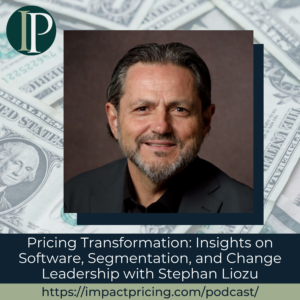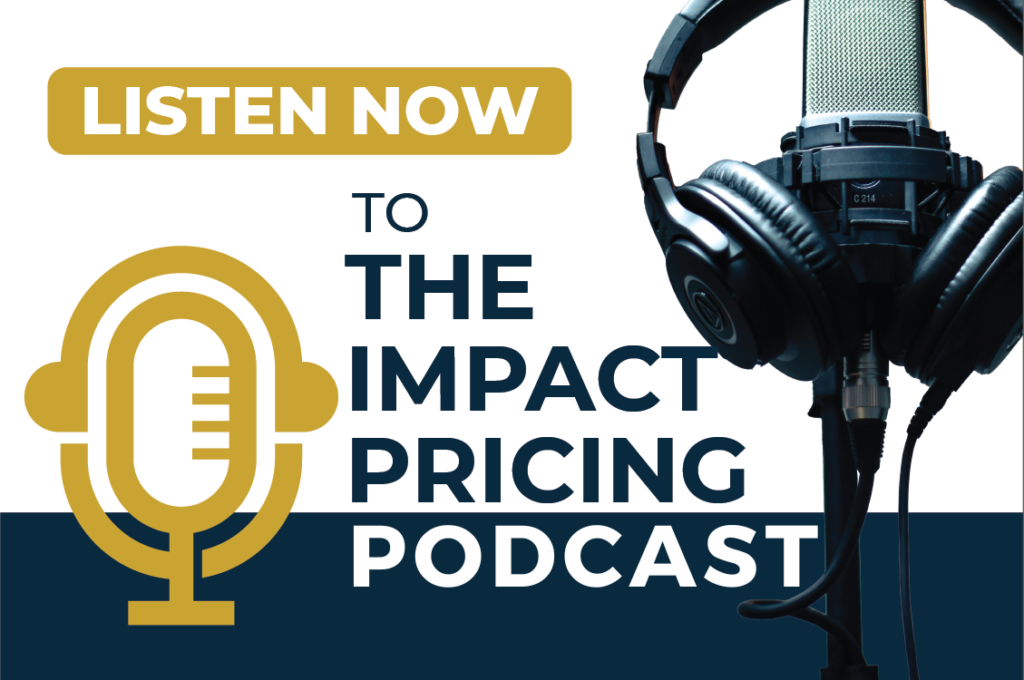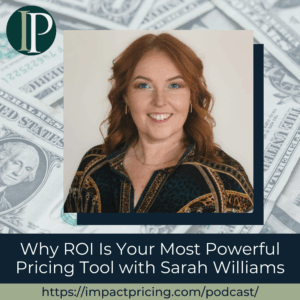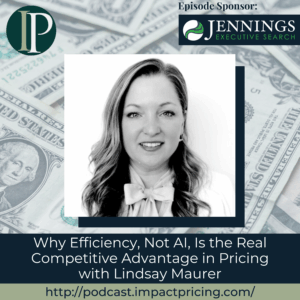Stephan Liozu is a business executive with deep knowledge in pricing strategy, value-based pricing, monetization, and transformations. He speaks the language of sales, pricing, finance, and the C-suite.
In this episode, Stephan highlights the need to combine value-based pricing with strong change management for successful transformations. He shares practical segmentation strategies tailored to diverse business needs. Reflecting on his move into pricing software, he explores its potential and the challenges of gaining C-suite support.
Podcast: Play in new window | Download
Why you have to check out today’s podcast:
- Delve into the nuances of value-based pricing and its implementation and practical advice for businesses aiming to maximize profitability while addressing internal and external challenges.
- Learn about a methodology for effective customer segmentation, practical steps, and real-world applications for targeted strategies.
- Discover the critical role of change management in successfully implementing pricing strategies and have a deeper understanding of organizational dynamics and leadership in pricing transformations.
“You cannot do advanced pricing without advanced change management and change leadership.”
– Stephan Liozu
Topics Covered:
01:10 – Significance of the Chief Value Officer (CVO) title
01:58 – The complexity of defining value within companies
02:52 – Contrasting his roles as a Chief Value Officer at Thales and Zilliant
04:35 – Reflecting on the challenges and uncertain future of the pricing profession with his article on LinkedIn
06:27 – Discussing the challenges of B2B pricing which hinders value-based pricing and the scalability of pricing strategies
12:11 – Advocating for internal pricing centers of excellence as cost-effective
14:01 – Explaining his approach to segmentation
17:26 – Stephan expressing excitement about his Zilliant role, exploring pricing software’s potential and questioning its limited market growth
19:07 – The challenges of convincing the C-suite to invest in pricing solutions, suggesting on reframing pricing discussions under a new term
22:31 – Stephan’s best pricing advice
Key Takeaways:
“If you want to industrialize your processes in pricing and value, you have to use an engine, the heart of this engine is software. And be able to touch all the business if possible, at least a large amount of the business.” – Stephan Liozu
“Pricing professionals should become certified change managers, it should not be an option.” – Stephan Liozu
People/Resources Mentioned:
- Thales: https://cpl.thalesgroup.com/software-monetization/software-packaging-pricing
- Zilliant: https://zilliant.com
- McKinsey: https://www.mckinsey.com
Connect with Stephan Liozu:
- LinkedIn: https://www.linkedin.com/in/stephanliozu/
- Website: https://www.stephanliozu.com/
Connect with Mark Stiving:
- LinkedIn: https://www.linkedin.com/in/stiving/
- Email: [email protected]
Full Interview Transcript
(Note: This transcript was created with an AI transcription service. Please forgive any transcription or grammatical errors. We probably sounded better in real life.)
Stephan Liozu
You cannot do advanced pricing without advanced change management and change leadership.
[Intro / Ad]
Mark Stiving
Welcome to Impact Pricing, the podcast where we discuss pricing, value, and the inflationary relationship between them. I’m Mark Stiving and I run bootcamps that help companies get paid more. Our guest today is the one and only Stephan Liozu. Here are three things you’ll learn about Stephan before we start. He is the Chief Value Officer at Zilliant. He’s one of the few people I know that has a PhD in pricing. And by the way, he’s the very first person I’ve ever seen that has the title, Chief Value Officer. He got that at Thales. Welcome, Stephan.
Stephan Liozu
Thanks for having me again. Pleasure to be on your podcast.
Mark Stiving
It’s going to be fun. Hey, so, tell us about the title Chief Value Officer, just because I love that title.
Stephan Liozu
Yeah, it’s interesting because at any point of time you have three or four CVOs in the world. And right now among them, Ibbaka just named a CVO, you have two or three more. So we’re now five or six in the world. But pretty much, I added that, the title at Thales, and I wanted to keep it because it’s really all about value. When you’re in software whether you are doing ROI calculations, business value assessments, but if every innovation and delivery, it’s all about value. So I wanted to keep the CVO role and then really make sure that everything we do is about value, customer value.
Mark Stiving
Yeah. So I find it amazing that so many companies don’t actually understand what value means to their customers. What value means to them.
Stephan Liozu
Well over the years I’ve done quite a bit of pricing assessment. And when I do my interviews, my discovery interviews, I ask them, what does value mean to you? In any company, you usually get between three and five internal definitions of value, which make it super complicated. Financial value, business value, customer value, value is cheap, shareholder value, profit, value is profit or margin. And at the end of the day, customer value is really at the bottom of the ranking.
Mark Stiving
It really is. And so do you see your role… Pick any company, right? Not necessarily Zilliant because Zilliant is a pricing company, but if you go back to Thales, do you see your role as making sure the internal workings of the company understand value, deliver value, and then capture value?
Stephan Liozu
So in Thales, I was more an internal facing CVO, which means I didn’t go out to customers and did live value selling, value prop delivery. I was making sure that all the functions really focused on customer value. At Zilliant, I’m the opposite. I’m going out to the customer, making sure that we talk about value to them, that we project an internal value to them, and we do beautiful business value assessments.
Mark Stiving
Yeah, and I would guess, I mean, it sounds almost like you’re a sales person when you think about going external to do value, at least that’s the way I would think salespeople should behave.
Stephan Liozu
That is correct. So more around sales enablement. So for example, I’m helping build a value playbook. As I mentioned, we are looking at business value assessments, automating this, but also in the product roadmap, making sure that everything we do brings differentiation and value, which is a huge change of mindset. So, I remind everybody in Zilliant and in Thales that we’re competing and we’re competing for the customer share wallet, which is a share of value that we can allocate to a vendor. And we got to be sure, we got to be crisp, and compelling.
Mark Stiving
Yeah. Just like every company has to be, so, right. Yeah. It just makes sense. Hey, the reason I invited you today, A, because I like you, but B, because you wrote a post the other day that I read on LinkedIn that was about the future of the role of pricing, right? And it just struck me as a really interesting question. Got me thinking a few interesting thoughts, and so I thought, ‘Hey, let’s have Stephan on and have a conversation.’ Let’s start with a quick overview. What did the article say?
Stephan Liozu
Well, you know me, I’ve been for the past 10, 12 years in the pricing profession and try to shake things up in there and really move the profession to a more robust growing profession. And I’ve been puzzled that it’s not like we are viral in essence in the go-to market space. It’s not like the pricing software companies are exploding in growth. Pricing is a transient profession. So I’m looking at all that situation and I’m like, ‘Well where do we belong? What is the future for us?’ Because we’ve been a scientific and quantitative function for many, many years. You look at in the sixties we did regressions, and now we’re talking about the Euro network and AI and all that stuff.
But at the end of the day, it’s not like we’re booming and it’s puzzling to me, and I was wondering, where do we go next? Where is the pricing profession and the science going towards? Is it more AI, is it more revenue intelligent? Is it more commercial excellence? Analytics, pure analytics? Because as a profession, as a standalone profession, it doesn’t look like we’re going to change anytime soon. So that was, I was writing that paper just to be a little bit controversial.
Mark Stiving
Yeah. As I thought about the problem after you wrote about it, my instantaneous reaction is there’s a huge difference between B2B pricing and B2C pricing. Because in my view here, B2C, we have tons of data. We have tons of data analytics. In fact, we’re probably not even thinking about what’s value to the customer. We’re thinking about what’s the price elasticity, and how do I do a promotion on Tuesday? Right? What do I think the results are going to be? And in B2B, we never do that.
Stephan Liozu
It’s supposed to be in the optimization engine but a fraction of companies in B2B do pricing the way it’s supposed to be, where you go to B2C because they’re data rich and they have no choice to compete, then, they leverage the power of pricing much more, I would say, in a deep manner. And it’s really about revenue management. And typically you would see pricing folks, revenue management folks working very closely with category managers, marketing managers, product managers, where in the B2B world, we’re still siloed into functions that really don’t work well together if they do have the pricing function if they don’t have a pricing function, then all that stuff doesn’t happen. It’s home cooking. Like we say in French, bricolage.
Mark Stiving
So, in B2C, I’m going to drop this one in just a second. In the world of B2C, it feels like the future of pricing is pretty obvious, right? It’s truly data analytics, it’s big data. It’s understanding AI, what should be able to do with AI and so it feels like it has a clear home there. Now in the world of B2B, that’s absolutely not true, right? It just does not feel like it has a home anywhere in B2B today.
Stephan Liozu
Well, I think, again, when you look at the advancements in business models in B2C, where with the direct to consumer model, with e-commerce, they just have no choice to integrate all the functions. So the marketing analytics works with the pricing analytics, which works with the sales analytics, and then all the supply chain is fully integrated. And I think we went through a revolution in the last 10 years around the business models and the power of data. In B2B, we’re not there yet. Yes, some companies are doing a bit of D2C direct to consumer, some e-commerce is popping up. But it’s a very traditional way of doing business.
And unfortunately that integration doesn’t exist. So you have very advanced functions like supply chain, maybe business intelligence. And then you have other functions in the go-to market that are very manual pricing. Pricing, if it’s not using software, it’s going to be excel and manual. A lot of times selling is manual. I mean, you look at the McKinsey number, only 30% of sales is automated in B2B. It’s crazy. So then you can’t leverage the analytics much and the maturity is not there. So, I think we need to think in terms of integration and alignment of all the blocks of the go-to market.
Mark Stiving
Yeah. It feels to me, like part of the problem in B2B is there isn’t a standard customer, right? So the thing in B2C, which we see so often is, first off, there’s thousands and thousands of buyers, right? We tend to use take it or leave it pricing. So we set a price and they buy it or they don’t buy it. And in the world of B2B, it feels like every customer is different. We have salespeople negotiating individual prices with each customer. And so it’s just so hard to say, here’s what value means, or here’s the price point we’re going to set. It’s really what’s the process we use to capture the most of what that customers are willing to pay.
Stephan Liozu
Right? But the fundamental issue that I see here, and I’ll be very honest with you, Mark, is I’ve worked with dozens and dozens of companies and I’ve written proposals, and they just don’t do customer segmentation. I mean, so at the end of the day, everybody gets the same, or it’s customer by customer. And I think in the B2B world, it’s a disease and I talk to many companies which think that we’re doing segmentation, but they’re doing thermographic segmentation, market segmentation, product segmentation.
And at the end of the day, that creates the problem that you say. It’s not segmen- driven. It’s too one-to-one instead of one-to-many. And I think you can’t leverage the one-to-one, it’s not scalable.
Mark Stiving
Right. Which is where I think the problem comes in with the role of pricing, right? It’s the fact that we want to play a role in helping understand value, but we can’t be involved in every deal. We can’t be involved in every customer.
Stephan Liozu
Yeah. But the issue is we know what we need to do. We know about segmentation, we know about elasticity, we know about value-based pricing. The other functions, we don’t know. So you go to a marketing team and you ask them, ‘Hey, where’s my segmentation?’ And you look at the segmentation, and if you are a well educated pricing person, you’re going to look at this and say, well, that’s great, but this is an account segmentation, A, B, C. There’s not much I can do here unless I’m going to do pricing based on the size of the account, which is great, but it’s not like the ultimate goal.
So, when I train about pricing and value-based pricing, I think a lot of what I train about is outside of pricing. And it’s a conundrum, because really segmentation is part of marketing, and value-based selling is part of sales. But we have to tell them what to do in order for us to do good pricing. And this is why in the paper I was writing, is it more of a commercial excellence approach? Is that more revenue excellence? Because pricing itself right now is not really integrated in other functions.
Mark Stiving
Yeah. So, first off, I have to say, I agree with you a hundred percent on the training of pricing story, right? In fact, for so long, I’ve been trying to figure out how to get away from saying the word pricing and just saying, look, I teach value. Right? But nobody cares. And so you have to say, I teach pricing.
Stephan Liozu
Right. Or you say value in pricing is what I do.
Mark Stiving
Yes, but given what you had just said in the role of pricing, the story that I think I liked the best in the world of B2B, I first saw it at Google, and that was, they had internal pricing consultants. So they had a pricing department, but the pricing department went around to all the other departments in the company to help them understand pricing and value for each of those departments. And I think that’s a phenomenal role.
Stephan Liozu
So this is in theory what center of excellence must do, right? So they are an internal consulting arm, and they’re going in and training and doing projects internally. Unfortunately, the CEO and CFO sees this as a cost and not a profit center. And as soon as there is a cost-cutting exercise, the CEO is cut. And we see that now. We see many companies cutting the center of excellence with lots of highly paid experts. And they’re decentralizing in the regions with very minimal expertise.
So, but I agree with you in as far as integration of the skills and the functions, being able to reduce the budget that you would spend with consultants and all that good stuff, having three or four or five full-time experts can really accelerate things and make sure your commercial excellence projects, your value-based pricing projects, even your pricing implementation projects are very successful. Otherwise, you rely on partners, you rely on implementation partners or consultants, and it’s expensive.
Mark Stiving
Yeah. So, I want to jump back to segmentation for just a second, if you don’t mind. What do you do, or how do you teach people to do segmentation? Because this is a big topic.
Stephan Liozu
It is. I have a process that I design based on multiple projects. I’ve done about 2000 segmentation projects. Some of them in B2G is this government, some in B2B, and then a few in SaaS. Right? I think B2C is moving towards personalization and micro segmentations because they have a huge amount of data, and I think there is no worries there, they don’t survive if they don’t do it, so they have to do it.
But in the B2B world I really go deep and that myself with the teams and do that with them. I show them a methodology, and usually we do either an active customer segmentation or we do a total customer segmentation with prospects and lost customers, depending on the scope that we want to focus on. And then we just deploy it. The key here is to go all the way and all the way means the execution of the segmentation in the service programs, in the cost to serve analysis in the deployment of assets and resources and marketing.
And that’s usually where it gets very tricky, because you could give them a very good segmentation where, let’s say with five to eight segments, but then you have to redesign some of the functions to be able to serve the customer based on what the segments require. And it’s difficult. But it’s totally doable. I usually spend 90 to 120 days doing that. It does create a bit of friction but it’s more of a cultural thing than a business topic.
Mark Stiving
Yeah. Well, one of the things I find when I do segmentation with companies is I try not to do the, here’s your seven segments. I try to do, here’s one segment, keep doing what you’re doing, but go chase this segment. And after you’ve been successful, now we can go pick another one and go chase that one. But let’s figure out how to handle one segment.
Stephan Liozu
I usually start with the opposite. I get a whiteboard and I say, well, okay, give me some value buyers who are really buying on value, there are partners. And then we list like maybe 15 accounts, 20 accounts. And then give me the opposite. Give me the kamikaze price buyers, the options guy, the close envelope bids like the crazy dudes who want a discount right away. And then we list about 20 of them. And you’re right, you start with this and it becomes already a reality because you put names to the segments and then you ease in the rest. Sometimes you have different types of value, buyers, technical or service value buyers.
And then the same with price buyers you have strategic ones, you have opportunistic price buyers, then we start dividing them. And I think the problem with segmentation is very theoretical. I think it’s in the minds of people that we look at this and say, ‘Oh, I don’t know how to do this.’ And until you show them the method and the right vocabulary there is a lot of confusion between the classification criteria, qualifying criteria segmentation criteria, people are totally lost because we have never done it before. So, but you are right. I think easing in the process and going step by step is the best approach.
Mark Stiving
Yeah, absolutely. So, Stephan, any words you’d like to share with us about the new role at Zilliant?
Stephan Liozu
Oh, the role is exciting because I’ve been doing transformations for 12 years. I’ve been helping all kinds of different companies really redesign the go-to market and be, like you said, very value oriented. And the heart of this engine is software. Because you can do things manually forever. And if you want to industrialize your processes in pricing and value, you have to use an engine, right? And be able to touch all the business if possible, at least a large amount of the business.
So I was always involved with software and whether it’s value-based pricing software, monetization software, billing software, or optimization and price management software. But I actually never went in there. So I was fascinated with the power of software. And I also wanted to try to really understand why is the software space only a billion-dollar space when all the rest of the space is booming, right? Like CRM, ERP, procurement software, they’re all exploding and we’re not.
So I wanted to go behind the curtain and see what’s happening, what is science all about? What do we mean by optimization, CPQ and the link between one block and the other. So looking at end-to-end pricing software or lifecycle pricing, It’s phenomenal. The power of science is rather intimidating, but also shows a great opportunity for the future. Now, the next question Mark, is, why is the space not $20 billion?
Mark Stiving
I was about to ask you that.
Stephan Liozu
Well, I’ve written many, many times about this many times. And I keep writing it. And I have a few papers coming out with PPS and one of them is about convincing the C-suite. We’re, I think we’re still, we have not cracked the nut on how to convince the C-suite. We’re not there yet.
Mark Stiving
So, I’m going to share a quick story with you. When I was at National Semiconductor, I tried to get a new pricing system brought in, failed dramatically, right? But I would go around and say things like, ‘Look, we’re going to get 5% return on this thing, right?’ I mean, this is huge. 5% of revenue is profit. This is huge. Nobody cares. I end up shifting jobs. I’m over at maximum semiconductor running pricing over there. And instead of walking in and saying, ‘Hey, we’re going to do 5% return,’ it’s walking around to every single department asking them, what are the pricing problems you see, articulating the problems, quantifying the value. If we could solve those problems, taking that to the C-suite, and then they’re like, ‘Oh, this is real money. Yes, we’ll go get one of those.’
Stephan Liozu
Yeah. So I hear you, and every company requires a different story. And that’s a little bit of the complication. Working in software now with many prospects, I ask them the pains and the challenges, they’re all different. So that means you have to tailor a story for every customer and prospect. And then you have different styles of CFO and CEOs. Some are techie oriented, some are more business oriented.
But generally speaking, I would say when you mention pricing and pricing tech, it creates a lot of anxieties. And I think you get that different look from the C-suite saying, ‘Yeah, do I want to mess up my pricing now?’ Right? ‘Do I want to upset my customers?’ And the problem is, all they’re read in the news is issues with dynamic pricing, gouging, failures, customer backslash or rebellions.
And I think that we haven’t yet addressed the risk management aspect of pricing and reduce the anxiety by showing implementations that work, the ability to demonstrate the value that’s realized, which I think we don’t do a good job at. And it’s tricky as you know, Mark, because in the margin, many things move. And I think you got to be able to show, well, here’s my margin bridge. Here’s a pure effect of pricing. And not everybody does this. And the simpler reason for that, Mark, is because pricing people are geeks. They’re not storytellers.
Mark Stiving
Yes. Well, and so not only are CEOs afraid to upset customers, but they’re going to upset salespeople. They’re going to upset the marketing team, they’re going to upset the operations team. It’s like everybody cares about pricing. Nobody seems to truly own it.
Stephan Liozu
But it goes back to what you were saying before if you use the word value, they don’t get it. If you use the word pricing, they run away. We don’t want to hear it. So for the past 10 years, I’ve tried to come up with a new word. Is it revenue management? I don’t know. I wish we could coin a new term, right?
Mark Stiving
That resonated with people. Absolutely. So, hey Stephan, we are running out of time, but let me ask you the final question. What’s one piece of pricing advice you would give our listeners that you think could have a big impact on their business?
Stephan Liozu
The number one thing that I realize and I knew before, but I realize even more nowadays, you cannot do advanced pricing without advanced change management and change leadership. I knew that for sure before I started working in software. I know it now tenfold because I’m in it. And pricing professionals should become certified change managers. It should not be an option.
Mark Stiving
Yeah, I think that’s an absolutely true statement, right? Because if we’re going to change pricing in a company, we touch so many different departments, as we just talked about, everybody cares. So you have to be knowledgeable or experienced and change management, right? Absolutely.
Stephan Liozu
For sure.
Mark Stiving
Stephan, thank you so much for your time today. If anybody wants to contact you, how can they do that?
Stephan Liozu
The best way is LinkedIn. And the second best way is stephanliozu.com. And then you have my contact information, all my papers, comics, and the links to the book. So one or the other.
Mark Stiving
Excellent. And to our listeners, thank you for listening. If you enjoyed this, would you please leave us a rating and a review? And if you have any questions or comments about the podcast, or if your company needs help getting paid for what their true value is, feel free to email me, [email protected]. Now, go make an impact!
[Ad / Outro]

















